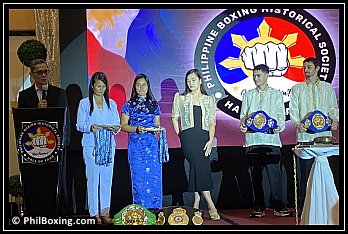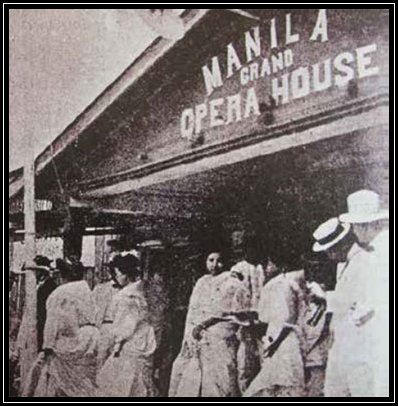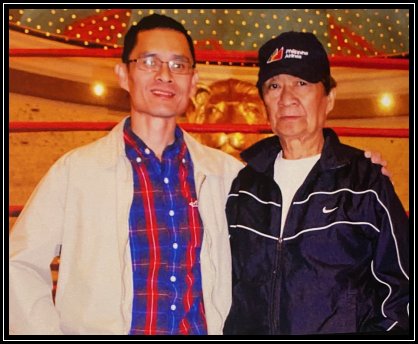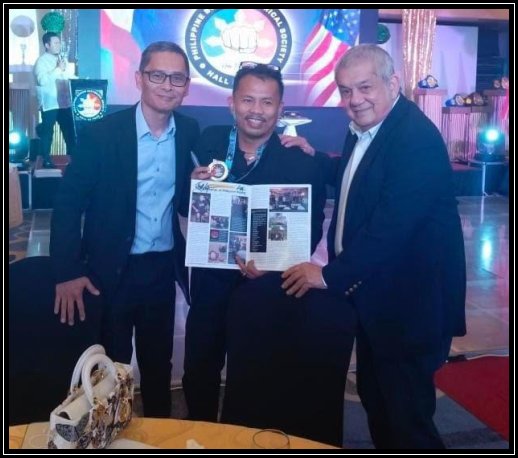
|
Philippines, 19 Dec 2025 |
Home >> News |
 |
||||
|
|
|
|
Preserving a Legacy: The Birth of the Philippine Boxing Historical Society By Dong Secuya PhilBoxing.com Thu, 28 Mar 2024  History. Legacy. Passion. Veneration. These words encapsulate the launching of the Philippine Boxing Historical Society last Saturday, March 23, 2024 at the Manila Grand Opera Hotel located in the heart of the bustling and storied city of Manila. The Society is the brainchild of Emmanuel Rivera Jnr, -- Noel to friends and family -- a driven and tenacious investigator and collector who has uncovered and brought to light many rare artifacts, mementos, news clippings, and vignettes, illuminating the journey of Filipino pugilists spanning over a century. The Venue When I received the invitation to attend the event, I was wondering why hold it at the Manila Grand Opera Hotel? Aside from its unfamiliarity, it is located in the unglamorous part of town right beside a swamped train station that on its busiest hours is teeming with a mass of humanity. It is no secret that the area where Quezon Boulevard in Quiapo and Avenida in Santa Cruz interacted by Recto going to Divisoria in Binondo is a labyrinthine nightmare where bargain hunters, hawkers and pickpockets congregate. Yet, as I immersed myself in its historical significance, the wisdom of this choice became clear to me. The Manila Grand Opera Hotel stands upon the hallowed grounds where the illustrious Manila Grand Opera House once reigned supreme. In its glory days during the colonial era from the early 1900s to its decline and destruction during World War II and its reconstruction and revival after the war, the Opera House was the epitome of grandeur. It hosted luminaries from the highest echelons of society, captivating audiences with the finest local and international performances. Moreover, it served as a nerve center for political, business, and social gatherings of paramount significance. In 1907, the Opera House hosted the Philippines' first General Assembly where 80 delegates from all over the country were elected. It was also the venue for the First Independence Congress in 1930 "where the country's well-known personalities in politics, education, social and cultural circles, economy and religion congregated to foster the Philippines' bid for independence from the United States." [1] 
Old photo of the Manila Grand Opera House. 
A marker of the Manila Grand Opera House. But what ties this illustrious venue to the world of boxing? A tale recounted by the Lexington Herald in 1920 sheds light on this connection.. The then Philippine senate president Manuel L. Quezon, who was watching a stage performance on a Saturday night at the Opera House, was incensed after being disturbed by the shouting that went on at the nearby Olympic Stadium where a boxing match was also in progress. The senate president "could not hear the singing because of the resounding cheers from the stadium for "Dencio." Dencio is the highly popular local boxer Gaudencio Cabanela who has been fighting regularly at the Olympic Stadium up to that point. Another incident happened when Quezon and Dencio "drove up to the opera house about the same time one evening and entered the foyer together, and that 'Dencio' received the greater recognition." Quezon later dug up an old law of 1910 that banned boxing and wanted it enforced but was persuaded otherwise by a cadre of fervent boxing enthusiasts among his peers. [2] Olympic Stadium -- The Cradle of Philippine Boxing This leads us to the Olympic Stadium, as we've learned, was located in the same block as the Opera House. By his painstaking and tenacious research, Rivera has now given us a clear picture of what transpired in the first quarter of the 20th century when the first batch of Filipino pugilists came onto the scene and who would eventually make their mark in the United States and elsewhere. 
The Olympic Stadium, 1934 photo. Rivera wrote that it was the trio of Francis Aglar Churchill, Stewart Alfred Tait and Edwin Ensign Tait who started organized boxing in the Philippines. Churchill and the Tait brothers were American soldiers and entrepreneurs who organized carnivals, cabarets, films and of course, boxing shows in Manila in the early 1900s until the 1930s. The watershed moment came in 1911 when the trio, who formed Churchill and Tait Enterprises for their entertainment ventures, made their first boxing show at the Olympic Boxing Club in Quiapo. They also had shows at the Palomar Pavillon in Tondo and later, when huge crowds could no longer be accommodated in the small arenas, constructed the Olympic Stadium along Doroteo Jose and Avenida, a property owned by renowned Tomas Mapua. [3] Churchill and the Tait brothers were instrumental in discovering and nurturing the pioneering careers of Eustaquio Duarte, the first Filipino professional boxer, Pancho Villa (Francisco Guilledo), the first Filipino world champion, Francisco Labra, Silvino Jamito, Gaudencio Cabanela, Elino Flores, Inocencio Moldez and Peter Sarmiento, among others. The Olympic Stadium ceased to exist in 1934 as a result of the death of Frank Churchill the previous year and after its lease with the Mapuas could not be renewed. [4] Tributes "I started collecting boxing memorabilia in the early 1990s when Louie [Espinosa] often came to our house," Noel told me. Louie is the former Filipino world boxing champion Luisito Espinosa, who was then managed by Noel's father, Filipino journalist Hermie Rivera. "Before I knew it, my collections grew tremendously, so much so that my wife often questions my sanity," Noel quipped. 
Noel (L) with his dad Hermie Rivera. Noel also acknowledged the influence of Hall of Fame American boxing journalist Jack Fiske (1917-2006). Fiske would bring him to his house to show him his own vast collections of boxing memorabilia that literally filled every space. Fiske and Noel's father, Hermie, later collaborated on an article ranking the all-time top 10 Filipino boxers. This experience, Noel admitted, inspired him to create the Philippine Boxing Historical Society. Rivera dedicated a function room of the Manila Grand Opera Hotel to display his collection of rare and original photographs, newspaper clippings, magazines, books, boxing uniforms, and gloves from Filipino boxing greats. Portraits of Eustaquio Duarte, Gaudencio Cabanela, Pancho Villa, Flash Elorde and others, created by painters Jun Aquino and Brian Bonbon, adorned the exhibit walls. 
Some of the collections on display. During its launch, the Philippine Boxing Historical Society inducted Filipino boxing pioneers into its Hall of Fame and presented awards to a select group of modern boxing aficionados who have made significant contributions to the sport. While the event's centerpiece was recognizing boxing personalities in their historical context, it was also an occasion for the Rivera family to pay homage to their patriarch, Hermie Rivera. A fixture in Philippine sports for several decades as a writer and broadcaster, he passed away in 2016. The Rivera family members who traveled all the way from the Bay Area in the United States included Noel's son Grant Rivera, Noel's sister Charina Rivera and Charina's daughter Keana Rivera. (Top photo). 
L-R: Noel Rivera, Edito Villamor and Antonio Lopez Aldeguer. The event itself drew a distinguished crowd with many boxing luminaries in attendance, government officials, and prominent media figures. The awards ceremony wasn't just about recognizing achievements; it was a celebration of the sport and a party. The crowd roared with delight as Luisito Espinosa himself stepped into the stage, shadowboxing and hitting the mitts with youthful energy, a nostalgic reminder of his championship days. Luisito Espinosa workout video: The following personalities are enshrined into the Philippine Boxing Historical Society Hall of Fame: 1. Eustaquio Duarte (July 4, 1889 - ?) alias Eddie Duarte from Daan Bantayan, Cebu - First Filipino professional boxer, fought from 1910-1920. Record: 9-8-8, 1KO [boxrec] 2. Francisco Labra (Jan. 1, 1895 - ?) from Cebu - Filipino boxing pioneer, fought from 1913-1925. Record: 24-18-20, 5KOs [boxrec] 3. Silvino Jamito (Feb. 2, 1894 - ?) from Talisay, Camarines Norte - Filipino boxing pioneer, fought from 1913-1928.. Record: 77-71-39, 12KOs [boxrec] 4. Inocencio Moldez (Jan. 1, 1901 - ?) aliases Clever Sencio and Binang Bullet from Leyte -- Filipino boxing pioneer. Record: 12-4-2, 2KOs. 5. Gaudencio Cabanela Sr. (Feb. 27, 1900 - July 2, 1921) alias Kid Dencio from San Fernando, Pampanga. First Filipino boxing superstar known for his exceptional footwordk and aggressive fighting style. Record: 32-7-5, 16KOs. 6. Luisito Espinosa (June 26, 1967 - ) alias Lindol from Manila. World featherweight champion from 1995-1998.. Record: 47-13-0, 26KOS. 7. Francis (Frank) Aglar Churchill - Father of Philippine boxing. Instrumental in staging boxing events in Manila from 1911 to 1933. 8. Stewart Alfred Tait - Master showman and the architect of Philippine boxing glory. Together with Frank Churchill and Edwin Tait, staged boxing events in Manila from 1911 to 1933. 9. Edwin Ensign Tait - Trancendent promoter of Philippine boxing. Together with Frank Churchill and Stewart Tait, staged boxing events in Manila from 1911 to 1933. 10.William Eli Miller - The bard who illuminated Philippine boxing in print. 11. Joseph Himan Waterman - The roar of the crowd is music to his ears. Waterman was also instrumental in developing boxing in the Philippines in the early 1900s. He discovered Dencio Cabanela and brought him to Frank Churchill.. 12. Aquiles Zonio - A veteran journalist and broadcaster from Mindanao who later became Manny Pacquiao's media relations officer in the Philippine Senate. 13. Joe Cantada - "Joe had a voice made for radio, a physique fit for the movies, and a mustache that changed the face of Philippine sports broadcasting forever." - Hermie Rivera. 14. Recah Trinidad - Veteran Filipino sports journalist who covered several Olympics and who penned the popular book "Pacific Storm: Dispatches on Pacquiao from the Philippines." 15. Dong Secuya - Chronicler of the Sweet Science. Secuya created MannyPacquiao.ph in 2003 that helped catapult Manny Pacquiao to fame. In 2005, Secuya created PhilBoxing.com that would become an institution as the goto website for boxing news related to Filipino boxers as well as mainstream boxing stars worldwide. 16. Antonio Lopez Aldeguer - founder of the famed ALA Boxing Gym and ALA Promotions which were instrumental in unshering in a golden era of boxing in the local shores by nurturing local talents and bringing them to the pinnacle of boxing achievement. ALA produced several world champions in Donnie Nietes, Milan Melindo, Merlito Sabillo as well as created highly popular boxers like Rey Bautista and Z Gorres. References: 1. Business Mirror: The Manila Grand Opera Hotel: Rich in history, luxe in Manila, Aug. 28, 2018 2. The Lexington Herald: Boxing Gloves Supplant Knives in the Philippines, Wed, Aug, 4, 1920. 3. Philippine Boxing Historical Society Magazine: Olympic Stadium, Page 28, Mar. 23, 2024 4. The Tribune: Cradle of P.I. Boxing Game May Be Memory Soon, Feb. 15, 1934 Click here to view a list of other articles written by Dong Secuya. |
|
|
PhilBoxing.com has been created to support every aspiring Filipino boxer and the Philippine boxing scene in general. Please send comments to feedback@philboxing.com |
PRIVATE POLICY | LEGAL DISCLAIMER
developed and maintained by dong secuya © 2025 philboxing.com. |